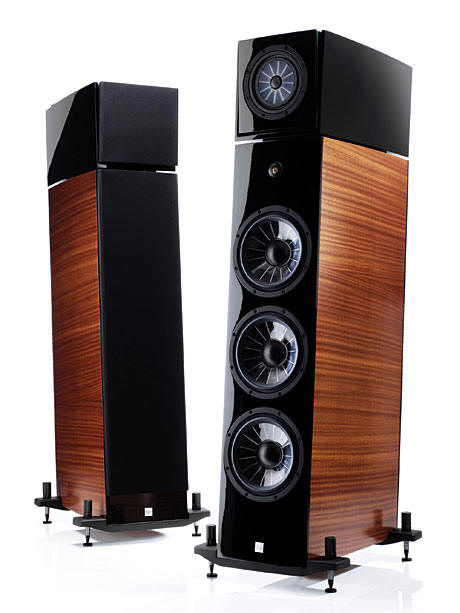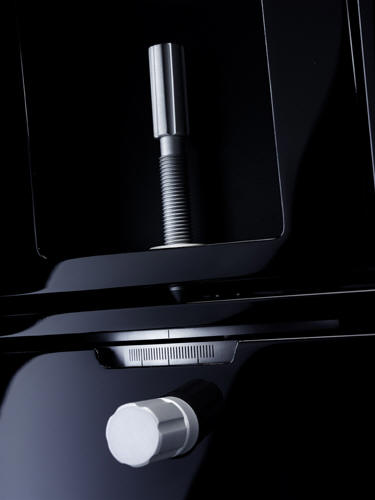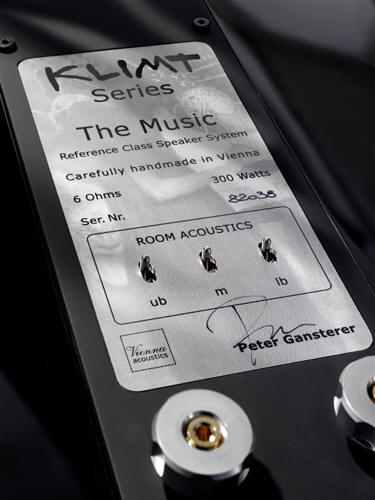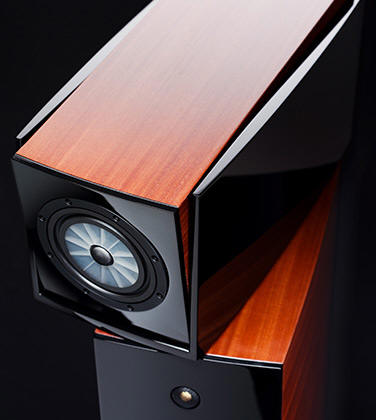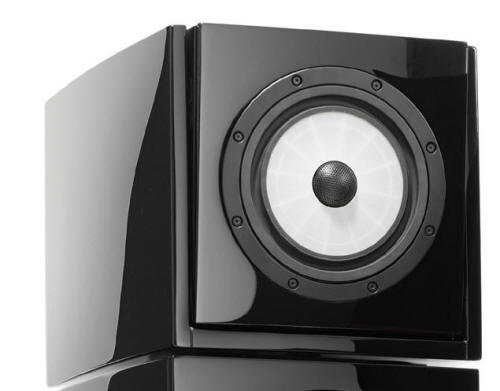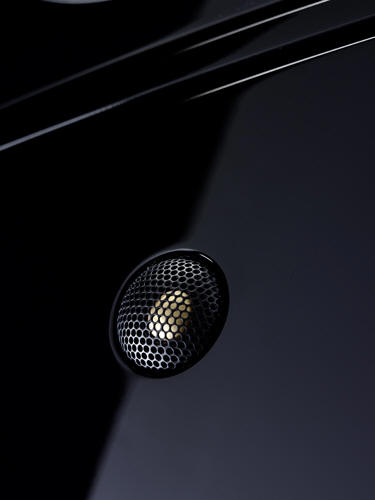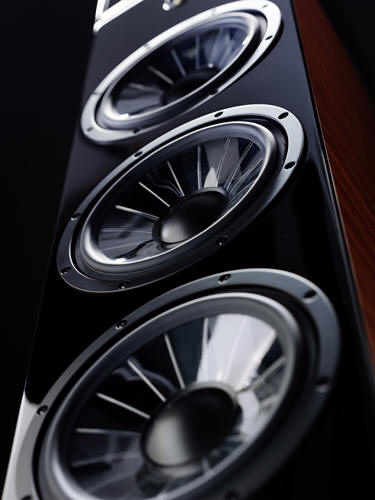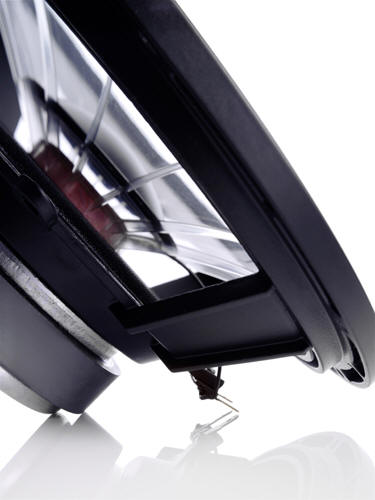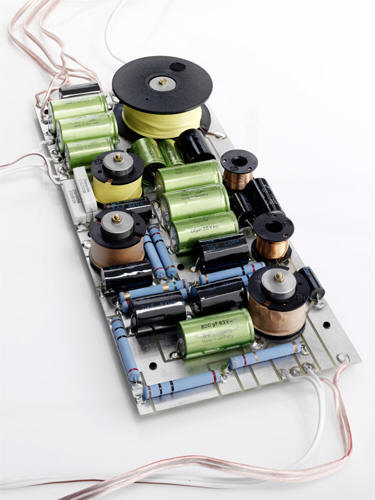|
|
You are reading the older HTML site
Positive Feedback ISSUE 59
vienna acoustics The Music Loudspeakers as reviewed by Guido D. Corona
Introduction The Music—called Die Muzik in German—is Vienna Acoustic's (VA) flagship product. Priced at a substantial $27,500 USD per pair, the elegant lines of this speaker's contour is a veritable technological tour de force. Like The Kiss, The Music's smaller brother, and the older Mahler speaker, The Music requires a prolonged break-in, followed by excruciatingly detailed positioning and orientation, which is best executed by a VA trained professional. In other words, patience is golden: only the patient audiophile will experience the living heart of The Music reference speakers, a powerfully textured world of sound that is as immersive as it is luminously enchanting. In harmony with a Viennese musical mood, I have structured this somewhat long review in two movements. The project is the result of a year long experience with a speaker that has since become a critical component of my reference system. The First Movement discusses in detail The Music's construction, technological breakthroughs, and some of the philosophy held by Peter Gansterer, VA's founder and master designer. The article is the fruit of hours of recorded interviews and follow-up discussions with Kevin Wolff, International Sales Manager for VA Worldwide, and Managing Sales Director of VA – North America, and with Patrick Butler, Sales Director of VA's North American operation. Thank you gentlemen for humoring so cheerily all my ever-picky queries! The Second Movement, to be published by PFO in the near future, will detail my listening experience. The article will discuss the behavior of the speakers driven by several solid-state amplifiers, ranging from the $4K Bel Canto REF500M class D ICE power-based monoblock, to the new $28K Jeff Rowland Design M725 class A/B monoblock. The recently introduced Shunyata Tron Anaconda speaker wires were utilized during most of the critical listening. Hence, without any further ado, here is… First Movement– Technology and Philosophy of a Reference Speaker When the freight forwarders delivery van parked in front of my 2-story home, I could not fathom why the three burly gentlemen would refuse to ferry two trunks containing a pair of VA The Music loudspeakers into my living room. The crew reluctantly agreed, after some cajoling, to move the behemoths at least into the garage, where after plaintive phone calls with their supervisor, whilst reciting arcane insurance regulations, further grumbling, muttering, hemming, hawing, and gnashing of teeth, the three burly men finally pushed twin wooden 360 lb sarcophagi, which measured 34.5" by 17" by 65" each, against a side wall. There The Music review samples rested, locked in their plywood cocoons, for almost one week, until Patrick Butler dropped by in person to set the speakers up in my listening loft at 9:17 AM on February 5th, 2011. Two hours later, the 180lb 4-way speakers had been lofted upstairs and assembled. Their adjustable Music Center heads had been fastened to articulated yoke-mounts pivoting on top of each main cabinet, while two massive milled aluminum foot braces had been bolted to each bottom plate. The Music is a quietly gorgeous speaker—available in two finishes: gleaming piano-black lacquer, or satiny Sapele veneer, painstakingly book-matched by Maria Gansterer—VA's Production Manager. Sapele (Entandrophragma cylindricum) is a finely grained and distinctly figured African wood outwardly reminiscent of mahogany, but taxonomically unrelated to it. As oil-based lacquers are banned in the European Union, and shellac lacquer is known to suffer from long-term maintenance problems, VA adopted an environmentally friendlier and durable polyurethane-based lacquer formulation for The Music. Accustomed as I was to the grace of my rosewood-finished Mahler V1.5s, their simple flat baffles and visibly raked vertical profiles softened by perfectly crafted quarter-round edges, I was concerned that the sharper vertical angles of the black-liveried The Music would look stark and severe by contrast. My worries were unfounded: the articulated VA flagships brought a sophisticated charm of their own to my music loft. Peter Gansterer has sculpted these substantial speakers with uncommon modern grace: their contour, measuring 51" tall, by 10.8" wide, and 24.8" deep, is a far cry from the eerie rectangular monolith of Clarke's and Kubrick's 2001: A Space Odyssey. The vertical baffles have been imparted an almost imperceptible cylindrical convexity, while the entire articulated structure is faintly raked back by five degrees to facilitate driver time-alignment, resulting in a three-dimensional totality that is subtly mesmerizing. Whether you fasten the magnetic cloth grilles to the front plane for that softer look, or prefer, as I do, to bare the driver subassemblies, and so gain an ultimate wisp of audible revelation, The Music remains quietly stunning: they exude that understated elegance of the European object d'art. Music Center Enclosure The Music consists of two independent cabinets that can be adjusted and oriented independently. On top, a sealed head, called the Music Center, features a proprietary extended range coincident flat driver that serves core midrange and treble frequencies. The massively braced MDF enclosure, which swivels inside a non-resonant cast aluminum yoke mount, remains completely decoupled from the main cabinet below. Interestingly, the mount is finished in the same piano black lacquer used for the rest of the cabinetry. Only the machined aluminum braces of The Music's footers feature a metallic finish. VA opted for cast aluminum over wood products for the yoke-mount, to ensure highest degree of stiffness and strength, while generous internal braces reinforce the MDF of the upper and lower enclosures to complete structural non-resonance.
The azimuth raking and horizontal swiveling of The Music Center alters the integration between the coincident driver and the three bass drivers below. The entire yoke-mounted top assembly operates very much like a gun-mount of old. The aluminum shoe swivels on a pivot point approximately 5" from the back of the unit, and allows for fine toe-in adjustments of the head. The Music Center's anchoring points support azimuth raking, which can be controlled by turning a large and finely threaded vertical brass screw mounted on the rear of the enclosure. Toe-in is performed by gently swiveling the entire head in its aluminum harness, and then locking the head into place by fastening an even larger horizontal hand screw emerging below the bottom of the assembly. Both screws sport six deep knurls for a comfortable grip. Two graphs at the back of the cabinet allow the user to establish repeatable setup patterns for rake and toe of the Music Center. Main Cabinet Enclosure The main cabinet is constructed from strategically braced MDF. The gently curved and raked front baffle features a 0.5-inch super-tweeter towards the top, while three 9-inch patented Spider-Cone™ bass drivers are aligned vertically below it. Three round ports open to the rear baffle. Twin side-by-side ports vent a large sealed chamber tuned to the deeper frequencies of the two bottom bass drivers, while the top port vents the smaller chamber housing the upper bass driver. The upper driver supports The Music Center's dynamic capabilities toward the lower midrange. Peter Gansterer is a strong believer in single wiring, and The Music is consistent with his philosophy, according to which, a truly well designed speaker does not benefit from the crutches of bi-wiring. The Music's single pair of oversized 4-way proprietary binding posts emerges toward the bottom of the back panel. The terminals connect to a first order crossover circuit, sealed in its own pocket, situated behind the lower bass chamber. Above the terminals, a horizontal line of three up/down rocker switches protrudes from the cabinet for convenient tool-free operation. These shape the speaker's response for unique room-dependent corrections. Flipping a switch to the upper position activates its contouring circuit; conversely, while resting in the neutral default position, all the switch's crossover components are taken off-circuit. From left to right, the three rockers activate:
Kevin remarked that these switches are not substitutes for careful in-room speaker placement. Speaker setup must be completed with all switches resting in the lower default position. After speakers are correctly set up and broken in, some contouring may occasionally be applicable to fit particular listening preferences, or unique acoustic environments.
A pair of massive machined aluminum braces is bolted to the bottom plate of each speaker. A large, hand-adjustable brass screw equipped with five shallow knurls is threaded through the left and right ends of each brace, and terminates in a floor-coupling spike at the bottom. The four screws can be regulated independently to decouple the braces from the floor, and to control the frontal raking angle of the main cabinet. Most of The Music's interior is empty. In spite of this, the speakers are considerably heavy. There is no secret behind the weight: the high mass of the strategically braced and beautifully finished cabinets, the substantiality of the drivers, the weight of solid aluminum yoke mount and foot braces, as well as the weight of the crossover components, add up to an impressive 180lbs. Oh, please remember to add 160lbs. for each of The Music's monumental shipping sarcophagi. Technology On the 16th of October 2010, Kevin Wolff and I chatted about the technology and philosophy underlying The Music, while enjoying a glass of Cabernet in the Soundings Hi-Fi reference room in Denver, Colorado. Challenges of Tweeter-Midrange Integration The heart of VA designs, starting with the Beethoven Baby Grands, up to Mahler V1.5, has been the midrange driver. VA speakers have served the core human voice frequency range, which is loosely defined to span from 90 or 100Hz, up to 1.2kHz, without crossover nodes through broad-spectrum midrange drivers of traditional design that operate from 100Hz to approximately 2.2kHz. According to Kevin, as tweeters are mostly crossed above 1200Hz, and hardly extend below such frequency, any claims that tweeters all by themselves are the sole secret to vocal clarity may be misguided. Yet, tweeters are responsible for reproducing higher harmonics, therefore it is undeniable that perfect integration of the tweeter with the midrange is key to superior reproduction of the human voice, and thus the heart of a reference-level speaker. Several manufacturers have attempted to tackle the midrange-tweeter integration problem by creating coaxial driver arrays, consisting of a midrange transducer combined with a concentrically mounted tweeter. Unfortunately, typical cones suffer from subtle horn loading, audible anomalies that are a function of the physical shape of the cone, and of frequencies being generated. Drivers that attempt to cover even broader frequency ranges through coincident classic midrange-tweeter array designs tend to suffer from phase alignment problems and horn-loading, as higher frequencies gradually generate more energetic activity closer to the transducer's throat and voice coil. Conversely, with lower frequencies, more of the cone surface is used, reducing horn-loading anomalies. Uncontrolled horn-loading anomalies may result in that subtle brashness, which can plague the middle range of coincident drivers that are not completely flat. Of course, to some extent at least, midrange horn loading and time alignment anomalies can be corrected through progressively elaborate cross-over design, which tend to introduce problems of their own. Designers have long known that a flat midrange driver design could avoid horn-loading problems. However, the realization of such flat drivers has posed problems that have plagued engineers' ingenuity for decades, as flat diaphragms tend to introduce unacceptable compromises of high mass and structural weakness, exemplified by the relative high mass of honeycomb-reinforced implementations. Coincident Flat Midrange-tweeter Array Peter Gansterer has solved the midrange-tweeter integration challenge in his creation of The Music. Using advanced computer modeling software developed in partnership with The Technical University of Vienna, he designed a novel coincident flat midrange-tweeter array driver capable of serving frequencies ranging from 100 Hz to 20 KHz, free of any midrange horn-loading or other distortive discontinuities. The tweeter-midrange sub assembly consists of two concentric elements: an outer driver featuring a VA patented flat Spider-Cone™ diaphragm that serves midrange frequencies from approximately 100Hz up to 2.3kHz with completely pistonic action. The driver is the direct offshoot from an early Gansterer patent, which resulted in the Spider-Cone™ bass driver used since 1996 by the Concert Grand series and by Mahler.
Concentric to the midrange, a custom 2.5cm hand crafted center vented silk dome tweeter, designed by VA and manufactured by Eton, is integrated into the empty cylinder in the middle of the flat diaphragm, and serves the treble region up to 20kHz. The tweeter is not only perfectly concentric to the midrange element, but is also accurately time-aligned with it; hence, VA prefers to describe it as coincident. Conversely, in a traditional coaxial design, the concentric tweeter may be mounted significantly in front or behind the midrange diaphragm, resulting in time mis-alignments. The motor of The Music's tweeter sports a synthesized neodymium-based magnet: permanent magnets fabricated from synthesized tetragonal crystals of neodymium iron boron compound (Nd4Fe14B) provide one of the strongest known magnetic energy and coercivity (magnetic force retention) in the world. The flat coincident driver array is mounted in The Music Center head, which pivots on top of the main The Music cabinet. The Music Center, also adopted on The Kiss, operates on a very wide frequency band between approximately 100Hz to 20kHz. It is designed to yield optimum time alignment, point-source coherence, and extremely wide dispersion characteristics. According to VA, elaborate crossover designs that attempt to compensate for driver horn loading almost inevitably have some subtractive impact on low-level information. Conversely, the patented flat Spider-Cone™ midrange driver and coincident silk dome tweeter array in the Music Center suffers from no horn loading, and does not require elaborate higher-order crossovers. The translucent white diaphragm of the 7-inch flat driver is molded from Vienna's own proprietary X3P material, doped with reinforcing glass fibers. The main component of X3P is TPX® (Polymethylpentene), the lowest specific density thermoplastic substance readily available, which VA sources in granular form. Unfortunately, a pure TPX® cone would not be as self-dampening as a traditional paper cone, nor would it be strong enough to withstand the high mechanical stresses produced by The Music. However, Peter Gansterer achieved remarkable strength and self-dampening characteristics by doping TPX® with two polypropylene variants. The diaphragm's mechanical strength is further enhanced during the molding process, by injecting very fine and light glass fibers in the molten X3P mass.
The construction of the Music's patented flat Spider-Cone™ midrange driver crosses European national borders: VA has designed the driver and the aluminum basket, and has partnered with Eton in Germany for motor, driver's surround, and construction. Diaphragms are cast in Austria. Bare cones are then flown to Eton, where they are integrated into driver subassemblies. Finished drivers are flown back to Vienna, Austria, where VA mounts them into complete speakers at its factory. While the retaining basket does not require low mass, it needs to be strong and non-resonant, lest it would add a sonic signature of its own to the output. For this reason, VA designed an expensive self-dampened aluminum basket, also contracted to Eton for manufacturing. Wolff observes that the coincident midrange/tweeter array driver used in The Music and The Kiss is the most expensive driver ever created in Vienna's product history. Computer Modeling With The Music, Peter Gansterer applied for the first time computer modeling tools to a development project. In particular, the 7-inch flat midrange transducer, as well as the 9 inch bass cone, were designed and optimized with the assistance of proprietary modeling software developed in partnership with The Technical University of Vienna, also used for structural analysis and simulation in the aerospace/automotive industry. The initial development of the flat driver was performed with the traditional manual iterative process, which is both very lengthy and costly: establish high level hypothesis; create detail designs; fabricate diaphragm prototypes; ship diaphragms to Eton in Germany for integration into lots of 100 working drivers; fly driver prototypes back to Austria; eventually test the resulting component live back in Vienna. After several frustrating and expensive iterations, which included the creation of more than five complete The Music prototypes, Peter Gansterer realized that he was not achieving the ideal sound that he was after, thus he started to explore more efficient development methodologies. He wondered that perhaps, creating and testing designs in a software-based environment, where ideas can be verified against known laws of physics before casting any hardware prototypes, might accelerate considerably a development cycle while reducing costs. Yet, modeling software should not only be able to validate designs that are close to optimum characteristics, but should also be capable of flagging flawed designs. Thus, to separate the wheat from the inevitable chaff, four outwardly promising software packages were selected for evaluation. These were tested against the early flawed driver parameters. Three candidates completely failed to detect any problems in the data: no matter what parameter combination was entered, the modeling packages predicted a successful driver. Fortunately, the fourth program, a proprietary suite developed by VA in collaboration with The Vienna Technical University, predicted correctly all the empirical failures already experienced by the early prototype, and could explain the physical causes behind each flaw. The winning program was of course adopted, and applied to the rapid iterative design of the flat midrange driver, and later to the bass driver. Assisted by this software, Peter Gansterer was able to optimize rapidly the desired performance of the diaphragms, while reducing significantly the number of actual prototypes, hence development time and costs. In particular, software modeling solved a very stubborn problem that had been plaguing Gansterer: the optimization of the position, depth, width, and intersections of the reinforcements on the back of the flat diaphragm necessary to yield a perfect pistonic behavior. Eventually, the software generated the most rigid diaphragm required for lower frequencies, having the lowest possible mass needed for a nimble reproduction of the higher frequency range, without the high mass of a brute-force Honey-comb implementation. Only then, physical prototypes were constructed. The result was a completely flat driver featuring 12 substantial X3P radial spokes integrated into its rear surface, and emerging from the central cylinder. The spokes taper and terminate approximately one quarter inch from the outer rim. A double concentric ring of geometrically complex X3P low-mass scalloped lunettes helps to reinforce further the outmost transducer area. The sonic performance of the final coincident flat array was judged by the development team to be a breakthrough over four and a half octaves, an so to be more than worthy to become the centerpiece of the new Vienna Acoustics flagship. Proprietary Ringed Super-tweeter All VA products feature proprietary drivers. While drivers are physically manufactured by great companies such as ScanSpeak in Denmark, Eton in Germany, and SEAS in Norway, they are all designed and developed by Vienna Acoustics in Austria. The sole exception to the rule, earlier The Music units, for example my review samples, feature an off-the-shelf OEM non-attenuating Piezo-electric Murata super-tweeter. Wolff explains that, while Murata remains one of the most reputable suppliers of this technology today, Peter Gansterer decided to create an even more suitable driver for its flagship product. Hence, recent The Music production units are equipped with a driver upgrade: VA's proprietary ring-type fully attenuating super-tweeter, which is physically manufactured by ScanSpeak.
The super-tweeter starts to operate at 17kHz, close to the upper limit of The Music Center's coincident driver range, and is thought to extend the speaker's highest frequency range well beyond 50kHz. According to VA, the new super-tweeter enhances The Music's ability to resolve the lowest level cues that outline acoustic space and instrumental images. Spider-Cone™ NAWI Hyperboloid Bass Drivers The Music features three 9-inch Spider-Cone™ bass drivers mounted vertically to the front baffle of the main cabinet. All bass drivers are wired in parallel to the same crossover output line, but are housed in two internal chambers tuned to different frequency ranges. The upper driver is served by a small chamber tuned to support the lower range of The Music Center. The bottom two are mounted in a larger enclosure and operate in parallel to simulate a much larger virtual driver, capable of reaching comfortably below 20Hz.
For over a decade, VA has applied Spider-Cone™ technology to the bass drivers of its larger loudspeakers. The technique braces each cone with a spoke-like pattern of X3P ribs molded onto the back. Spokes increase cone rigidity while limiting mass, and result in superior damping of the driver. Interestingly, Wolff observes that it was not necessary to design a flat diaphragm for The Music's bass drivers to achieve proper pistonic movement. The main reason for using flat drivers in the extended range coincident The Music Center is the problem of horn loading and beaming toward the transition point, between the midrange transducer and the silk dome tweeter component. Conversely, there is little or no horn loading produced by bass drivers, because low frequencies are produced by much longer waveforms that tend to exceed driver boundaries. As such, even a traditional conic bass cone is highly dispersive and omni-directional. The Music's bass drivers depart from the classic conic shape used in earlier VA speakers. Their curved surface derives strength from a unique curvature, which barely sloped at the outer rim, becomes gradually steeper toward the central throat of the diaphragm. The surface was not shaped ad hoc, but follows a complex mathematical function called a non-developable hyperboloid, or Nicht AbWIckelbar in German, which has been abbreviated to NAWI by The Music design team. In geometry, a developable surface can be unrolled onto a flat plane without stretching or compression, while a non-developable surface, well... it just cannot! Much more interestingly, hyperboloids are applied in engineering to realize structures that require particularly high strength-to-mass ratios, such as power plant cooling towers, and the nozzles of certain rocket engines.
The modeling software was applied to optimize the curvature parameters of the clear X3P hyperboloid, and so obtain the lowest mass and highest rigidity. Furthermore, the software optimized the spoke-like mechanical reinforcements on the back surface, where 15 slender spokes of X3P material taper gradually from the central hub up to the outer rim with a slightly steeper hyperbolic curvature, for the ultimate pistonic behavior. The resulting cone rigidity and low mass yielded cone self-damping characteristics much superior to anything achieved with the original manual prototyping techniques. The combination of the optimized NAWI hyperboloid with rear Spider-Cone™ reinforcement results in a mass that is comparable to that of a midrange driver, but having the size and strength crucial to the bass driver of a high-power and full range reference speaker. Gansterer believes that the NAWI paraboloid Spider-Cone™ has advanced significantly the state of the art of VA's bass drivers, as can be easily heard in the speaker's extreme bass coherence. According to VA, The Music's bass implementation has achieved a lower noise floor than previous designs, a more articulate, authoritative, and instantly percussive driver, which is simultaneously more insightful and incisive. Crossover Considerations Kevin Wolff observed that in many full range multi-driver speakers, human voice reproduction is broken into segments by audible crossover discontinuities, and is spread over more than one driver. Audible discontinuities in the reproduction of choral music by such speakers can be particularly severe. While a compact high-end 2-way monitor sounds great on choral music, because it renders the entire choir on a single driver, the same piece on a full range speaker may lose its clarity, as many midrange drivers cross over into an upper woofer at approximately 300Hz to 500Hz, resulting in parts of the choral texture fluctuating unnaturally between a large woofer and a much smaller midrange driver.
Undeniably, most designers rid their creations from audible discontinuities through elaborate crossover implementations. However, a well-trained human ear is often more capable of perceiving discontinuities than engineers are able to mask them. This is why VA consistently elects to tune the crossover point of bass drivers close to the critical 100Hz line, and so keep any such discontinuity out of the core of the human voice range. Gansterer has equipped The Music with a simple first order crossover that operates without any notch filters. It creates an environment where the subtlest micro-dynamics and low-level information can be revealed. VA's goal has always been to simplify crossovers with first order or very soft Bessel type second order designs, and so minimize passive components. The 4-way crossover controls The Music with two output lines into The Music Center, and four lines into the main cabinet: the super-tweeter, tweeter, and flat midrange, are each served separately by their own cable, while the three bass drivers are fed by three cables wired in parallel. Drivers are crossed-over at 17kHz (Super-tweeter to tweeter), 2.3kHz (tweeter to midrange), and 100Hz (midrange to bass). Of Philosophy and Components Peter Gansterer does not select a particular component in hope that its pedigree may lend outward prestige to a product, but because its performance has proven to be in maximum synergy with his project goals. This is why The Music's crossovers do not contain the very latest parts trumpeted by audiophiliac lore: no Black Gate capacitors for example. Rather, parts, from the humblest wire to the most exotic electronic component, are carefully sought and selected for their relevant measurements, and then evaluated against real audible performance. Interestingly, when Jeff Rowland, president of Jeff Rowland Design Group, inspected the crossover circuit of The Music speakers featured in the JRDG suite at CES 2011, he commented, referring to Peter Gansterer: "You really need to know how to listen in order to find and select these parts!" In other words, Peter Gansterer closely matched crossover part selection to instantiate the idealized sound that he had conceived. Measurements by themselves are neither absolute design yardsticks nor do they constitute ultimate goals. Rather, they are part of Gansterer's initial product creation toolkit, design landmarks on the way to realizing an incredible product, and remain relevant only if they are congruent with the audible result. Only the live listening evaluation, where parts under scrutiny are measured against actual audible results, is the ultimate yardstick of prototype performance and design success. Parts with theoretically favorable measurements that do not pass audible muster are cheerily discarded. Performance is Gansterer's sole dogma. More specifically—repeatable and reliable performance that is synergistic with the total product. For this reason, VA eschews second sourcing of any parts, components, cabinets, or processes. The company much prefers to partner with a scant handful of single sources—proven providers of consistent and reliable components, sub-assemblies, and services. These suppliers possess the high expertise and consummate artisanship required for VA's realization of absolute reference-level speakers. Since the recent upgrade to the new VA-designed super-tweeter, The Music is now an essentially European product. The entire speaker, from the massive cabinet down to the diminutive ringed super-tweeter driver, is designed by Vienna Acoustics in Austria; cabinets are constructed in Northern Italy by a high end furniture joinery; cones are cast in Austria; drivers are assembled by Eton in Germany and ScanSpeak in Denmark; all windings are performed at the VA factory; the final product is constructed, finished, and tested at the VA factory… in Vienna, Austria of course. Interlude - Two Previews Kevin Wolff remarks that the proprietary coincident array based on Gansterer's patented flat Spider-Cone™ midrange driver is a game changer and clearly points to VA's future, and that we should expect several upcoming Vienna Acoustics products to feature derivative forms of the Music's flat coincident midrange design. A clear harbinger of this trend was glimpsed at CES 2012, where VA offered a sneak-peek of the upcoming Beethoven Imperial Grand, an under $10,000 single cabinet 4-way speaker patterned on the form factor of the enormously successful Beethoven grand. Beethoven Imperial Grand will feature technology trickled-down from The Music: a smaller coincident tweeter-midrange flat array, and a variant of the proprietary Vienna ring-type super-tweeter. A triplet of Spider-Cone™ bass drivers sporting the classic conic shape, previously used in Mahler and Strauss, complement the vertical alignment of the front baffle. The new speaker will feature a stabilized bass similar to The Music's, and heavily braced front and rear baffles for a driver interface even quieter than the original Grand's. Finally, Igor Stravinsky, speaking from his 1946 Poetic Of Music, sternly warns that only "By its fruit we judge the tree. Judge the tree by its fruit then, and do not meddle with the roots. Function justifies an organ…" In other words, the massive amount of time, artistry, technology, and the intellectual capital expended in the development of The Music can only find its justification in the speaker's musical performance, lest Gansterer's effort would be for naught. Stravinsky's formalism nudges me to preview the conclusion of the next installment, where I discuss my year long experience with The Music, driven by several amplifiers, including the new Jeff Rowland M725 class A/B monoblock. With extensive setup and break-in, the VA flagship has gradually developed into an amazing musical instrument, a veritable source of joy, capable of illuminating the faintest sonic nuance extracted by the components upstream. The technological roots of Gansterer's master creation have borne a fruit that is more than deserving of its Viennese pedigree. Thus in the end, The Music has become my new reference speaker. Performance details, of course, wait in the next Movement of this review! Guido D. Corona Specifications Type: 4-way loudspeaker system with coincident midrange/tweeter driver array, integrated sub-woofers, and super-tweeter. Frequency Response: 22Hz-50kHz. Sensitivity: 91dB. Impedance: 4 ohms. Power Requirements: 50W to 500W. Driver Complement: one coincident Flat midrange/tweeter array driver, consisting of a 7-inch patented Flat-Spider-Cone™ midrange transducer combined with a coaxially-mounted 1-inch vented neodymium-magnet silk dome tweeter; one 0.5-inch super-tweeter; three 9-inch Vienna Acoustics Spider-Cone™ bass drivers. Dimensions: 10.75" x 50.98" x 24.80" Weight: 180 lbs each
The Music Distributor
Vienna Acoustics North America
|










